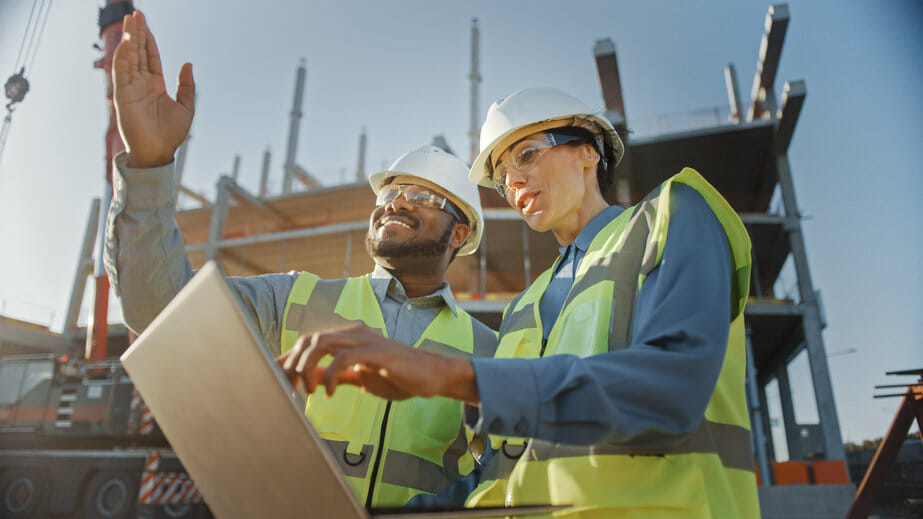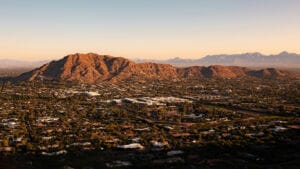Everyone is feeling the effects of the post-pandemic economy — event the Arizona construction industry.
From supply chain issues that haves new parents scrambling for baby formula and industrial builders scrambling for joists to rising inflation that has doubled the cost to fill up your gas tank, everyone and every industry has been impacted by the economic climate change.
Despite robust business, the construction industry has not been spared. To explore how the challenges of today’s economy are impacting the construction industry, AZRE magazine sat down with Ken Simonson, chief economist for the Associated General Contractors of America.
READ ALSO: Ranking Arizona: Top 10 general contractors for 2022
Impact of inflation on Arizona construction industry
AZRE: Phoenix is No. 1 in the country when it comes to rising inflation. How is inflation impacting the construction industry?
Ken Simonson: Contractors have certainly been feeling the run-up in costs of materials. It’s been far more extreme than the Consumer Price Index. An 8.6% year-over-year change in consumer prices sounds bad. And it is compared to an environment where we’ve had 2% or less for many years. Clearly, it’s a hardship for people living at the edge if they have to pay a lot more for gasoline, and food, and so forth. But for construction, we had 12 straight months in which the year-over-year change in input costs — that’s materials and services such as trucking and design services — that went up by 20% or more. We finally got a bit of a break in May. The increase in Producer Price Index (PPI) was “only 18.9%. Obviously, that’s a lot more than it’s been for consumer prices.
AZRE: We’ve heard a lot about lumber prices. Is that continuing to be a problem?
KS: Actually, lumber prices have plunged in the last few months on the futures market. I don’t know how quickly that’s showing up at the lumber dealer, or wholesaler, or the home improvement store. But because mortgage rates have gone up so much and house prices have gone up so much, there’s been quite a pullback in home building. As a result, the demand for lumber has tapered off rather steeply. But many other things are still contributing to this run-up in materials costs. For instance, many steel products, aluminum products, gypsum wallboard, paint, even concrete has gone up more than usual. And, of course, contractors use a lot of fuel, both to power their own trucks and off road equipment, and for the thousands of deliveries of equipment and materials and hauling away of equipment and debris at the end of a job.
AZRE: Is there anything the construction industry can do to combat any of this inflation?
KS: Well, contractors are not manufacturers or miners, so they can’t directly control those costs. What they’ve been doing is attempting to get owners to recognize what’s been going on, how extreme these cost increases have been, and try to engage in cost sharing, such as price adjustment clauses in a contract. Another thing I think owners have been more receptive to is buying materials much earlier in the process. This not only guarantees the price, but avoids an unpleasant surprise at the time they’re needed. Because in addition to the run up of materials costs, we’ve had these huge supply chain bottlenecks that have stretched out lead times or made them very unpredictable. No solution is perfect. You can’t store ready-mixed concrete or hot-mixed asphalt. But for things that have a long shelf life like steel joists, paint or wallboard, that can work if it’s protected from the elements.

Impact of staff and supply chain
AZRE: Is there an end in sight to these supply chain issues?
KS: A year ago, I would’ve said there’s an end in sight, but I’ve been taken by unpleasant surprise by so many things that I’m not prepared to say that the end is sight. First, the pandemic itself caused shut-down of factories. And then they reopened, but they couldn’t necessarily get full staffing back. And we had that incident with the Suez Canal being blocked for six days. And in February of 2021, a giant freeze in Texas knocked out production of the resins used in all kinds of construction plastics. Most recently, the long COVID lockdown in Shanghai held up deliveries of some products coming out of China. So it really is a whole bunch of things happening one after another.
AZRE: How are staffing issues impacting the construction industry?
KS: Contractors are really scrambling to find workers. There’s a series from the Bureau of Labor Statistics called the Job Openings and Labor Turnover Survey, or JOLTS. The latest reading showed that there were 494,000 job openings in construction. That was a 40% increase from a year earlier, and by far the largest end-of-April total in the history of this series, which goes back to 2001. It even exceeded the number of people hired during the entire month of April, which implies contractors wanted to hire twice as many people as they were able to find. So they’re paying a lot more for overtime. It’s taking longer to get projects done. They’re getting choosier about which projects to bid on.
AZRE: Do you see that continuing for the foreseeable future?
KS: I do. I’m concerned that the workforce issues are going to outlast even these supply chain and materials cost problems because we do have an aging workforce. We have probably more people retiring than coming into the workforce. Construction, historically, is very dependent on foreign-born workers. And immigration has really slowed dramatically in the last few years. So for all of those reasons. And then in addition, and you certainly know this in Arizona, construction work has to be done outside, in all kinds of weather, starting earlier in the day than I even like to get up. And now, people can, in other jobs, have a lot more flexibility about hours and working remotely or hybrid.
AZRE: How about labor costs?
KS: Historically, construction always paid a premium in what is called the Average Hourly Earnings of Production and Nonsupervisory Employees. Basically, that’s the hourly craft workers in construction and the hourly office workers also. Well, that premium — compared with the total private sector — used to be 20 to 23%. Since the pandemic, historically low-paying businesses like fast food , warehouses, and local delivery, have upped their pay from $7 or $8 an hour to $16 or $18 per hour. Construction hasn’t kept up. And so that premium has shrunk to 17% or 18%. So I think there are a lot of reasons that construction has all these job openings. And it’s going to be very hard to close that gap. They’re going to have to raise pay a lot more. And I think the industry will also turn more to offsite production where that’s possible or substituting machinery, robotics and so forth for labor where it can.
Impact of interest rates
AZRE: How are changes in interest rates going to impact the construction industry?
KS: Well, it’s mixed. Certainly, higher interest rates are already causing a pullback in home sales and single-family homebuilding. That may have a little positive spillover for those building rental apartments. The people who have been priced out of buying a home may be ready to rent a larger, newer or better-located apartment. Also, developers, whether of apartments, offices, hotels, etc., are certainly interest rate sensitive. To the extent that they are borrowing money for a project, those higher carrying costs mean fewer projects are going to pencil out. So while there may be a little boost in terms of a slowdown in single-family residential work, meaning more workers and materials might be available, not everything is transferable. Obviously, the kind of worker who puts up a single-family home and the materials they use don’t go into a high-rise office building just like that. So interest rate sensitive businesses like warehouse, retail, office, expect to see them cooling off. Now, other things, infrastructure by and large, or state and local projects, utility projects, manufacturing projects, they’re less interest sensitive because the funding is directly through tax sources or they have a very long horizon.
AZRE: How are things looking for Arizona?
KS: Arizona has been among the leading states for population growth for quite a while, so that’s fueling demand for many kinds of construction. Certainly, for housing, and for schools, for new roads, and underground utilities that go to those new subdivisions seem to stretch ever further out from Phoenix, and then public safety buildings and so forth. Many of those people, I hope, are bringing construction skills, too. So you are getting growth in construction employment, more than some other states. And I do think the things that are attracting people to Arizona now are largely staying in place. If you can find enough water to keep folks alive, then I think the prospects remain pretty good in Arizona.
AZRE: What’s your outlook for the construction industry?
KS: Well, I admit, I’m an incurable optimist. I don’t think we’re going to run into a recession. But even if the economy does slow sharply, I think construction still has a lot going for it. With the Infrastructure Investment and Jobs Act, that money seems sure to keep flowing. And lots of businesses have been making strong profits and have good reason to be investing. I think we’re going to need new manufacturing plants for things like offshore wind or battery charging stations for electric vehicles, the vehicles and the components of the vehicles themselves. So lots of reason to expect manufacturing construction to keep doing well. And so overall, I think construction will continue to grow in spite of these challenges.




